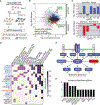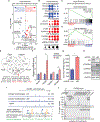ΔNp63α Suppresses TGFB2 Expression and RHOA Activity to Drive Cell Proliferation in Squamous Cell Carcinomas
- PMID: 30232004
- PMCID: PMC6219633
- DOI: 10.1016/j.celrep.2018.08.058
ΔNp63α Suppresses TGFB2 Expression and RHOA Activity to Drive Cell Proliferation in Squamous Cell Carcinomas
Abstract
The transcriptional repressor ΔNp63α is a potent oncogene widely overexpressed in squamous cell carcinomas (SCCs) of diverse tissue origins, where it promotes malignant cell proliferation and survival. We report here the results of a genome-wide CRISPR screen to identify pathways controlling ΔNp63α-dependent cell proliferation, which revealed that the small GTPase RHOA blocks cell division upon ΔNp63α knockdown. After ΔNp63α depletion, RHOA activity is increased, and cells undergo RHOA-dependent proliferation arrest along with transcriptome changes indicative of increased TGF-β signaling. Mechanistically, ΔNp63α represses transcription of TGFB2, which induces a cell cycle arrest that is partially dependent on RHOA. Ectopic TGFB2 activates RHOA and impairs SCC proliferation, and TGFB2 neutralization restores cell proliferation during ΔNp63α depletion. Genomic data from tumors demonstrate inactivation of RHOA and the TGFBR2 receptor and ΔNp63α overexpression in more than 80% of lung SCCs. These results reveal a signaling pathway controlling SCC proliferation that is potentially amenable to pharmacological intervention.
Keywords: CRISPR screen; head and neck carcinoma; lung cancer; p53; p63.
Copyright © 2018 The Author(s). Published by Elsevier Inc. All rights reserved.
Figures





References
Publication types
MeSH terms
Substances
Grants and funding
LinkOut - more resources
Full Text Sources
Other Literature Sources
Medical
Molecular Biology Databases
Research Materials
Miscellaneous

